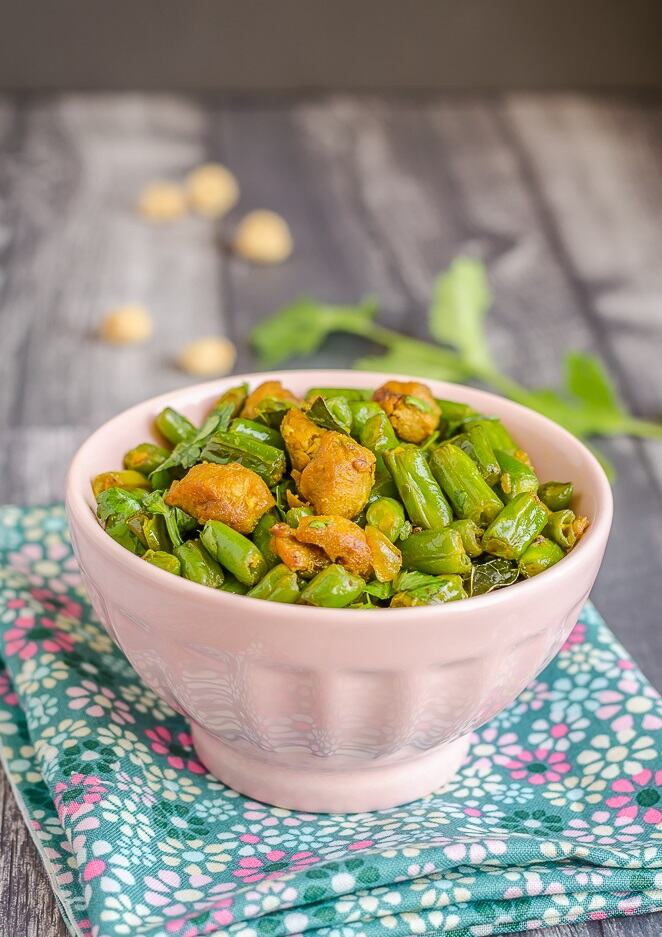Soya Chunks Green Beans Sabzi is a nutritious and flavorful vegetarian dish from Indian cuisine. It combines protein-rich soya chunks with fresh green beans, seasoned with aromatic spices like cumin, coriander, turmeric, and chili powder. This colorful and wholesome dish can be enjoyed as a standalone meal or as a side dish with rice or roti. It offers a delicious option for those seeking plant-based protein alternatives and is perfect for both everyday dining and special occasions.
| Ingredients | |
| 1 | 1 cup soya chunks (textured vegetable protein) |
| 2 | 1 cup green beans, washed and chopped |
| 3 | 1 onion, finely chopped |
| 4 | 2 tomatoes, finely chopped |
| 5 | 2-3 green chilies, slit lengthwise (adjust according to taste) |
| 6 | 2 cloves garlic, minced |
| 7 | 1-inch piece of ginger, grated |
| 8 | 1 teaspoon cumin seeds |
| 9 | 1 teaspoon coriander powder |
| 10 | 1/2 teaspoon turmeric powder |
| 11 | 1/2 teaspoon red chili powder (adjust according to taste) |
| 12 | Salt to taste |
| 13 | 2 tablespoons cooking oil |
| 14 | Fresh coriander leaves for garnish (optional) |
Step-by-step cooking instruction of Soya Chunks Green Beans Sabzi:
Step-1 Prepare Soya Chunks:
- Boil water in a saucepan. Once the water reaches a rolling boil, add the soya chunks and turn off the heat.
- Let the soya chunks soak in hot water for about 10-15 minutes until they become soft and double in size.
- Drain the water from the soya chunks and rinse them with cold water. After removing any extra water from the chunks, set them aside.
Step-2 Cook Green Beans:
- One tablespoon of oil should be heated over medium heat in a pan.
- Add chopped green beans to the pan and sauté for 5-7 minutes until they are partially cooked and tender. Remove the green beans from the pan and set them aside.
Step-3 Prepare Sabzi:
- Fill the same pan with the final tablespoon of oil. Spluttering, add the cumin seeds to the hot oil.
- Add chopped onions, minced garlic, and grated ginger to the pan. The onions should be sautéed until golden brown.
- Fill the pan with chopped tomatoes and green chilies. When the tomatoes are soft and mushy, add them and simmer.
- Now, add the partially cooked green beans to the pan along with the boiled soya chunks.
- Stir in coriander powder, turmeric powder, red chili powder, and salt to taste. Mix well to coat the vegetables and soya chunks with the spices.
- Cover the pan and let the Sabzi cook on low heat for about 10-15 minutes, stirring occasionally, until the flavors meld together and the vegetables are fully cooked.
Step-4 Garnish and Serve:
- Once the Soya Chunks Green Beans Sabzi is cooked to your desired consistency, garnish it with fresh coriander leaves (optional).
- Serve hot with roti, rice, or any other Indian bread of your choice.
Nutritional values of Soya Chunks Green Beans Sabzi:
The nutritional value of Soya Chunks Green Beans Sabzi can vary based on the specific ingredients used and the serving size. However, here’s a general overview of the nutritional benefits of this dish:
| 1 | Protein: Chunks of soy are a great plant-based source of protein. They are a complete protein source because they supply all of the important amino acids that the body requires. Green beans also contribute a moderate amount of protein to the dish. |
| 2 | Fiber: Both soya chunks and green beans are rich in dietary fiber, which aids in digestion, promotes satiety, and helps maintain a healthy digestive system. |
| 3 | Vitamins and Minerals: Green beans are particularly rich in vitamins A, C, and K, as well as folate and various minerals such as potassium and manganese. Tomatoes, onions, and other vegetables used in the sabzi also contribute additional vitamins and minerals to the dish. |
| 4 | Low in Saturated Fat: Soya chunks and green beans are low in saturated fat, making this dish a heart-healthy option. |
| 5 | Antioxidants: The vegetables used in Soya Chunks Green Beans Sabzi are rich in antioxidants, which help protect the body against oxidative stress and reduce the risk of chronic diseases. |
| 6 | Calories: The calorie content of Soya Chunks Green Beans Sabzi will depend on factors such as the amount of oil used in cooking and the serving size. However, it is generally a low to moderate-calorie dish, especially when prepared with minimal oil. |
Background History of Soya Chunks Green Beans Sabzi
The history of Soya Chunks Green Beans Sabzi is closely tied to the evolution of vegetarian cuisine in India and the increasing popularity of soy-based products in the country.
Origin of Soy-Based Products in India: The use of soy-based products like soya chunks in Indian cuisine gained prominence in the latter half of the 20th century. Soybeans were introduced to India as a commercial crop in the 1950s and 1960s, primarily for their high protein content and versatility in food products.
Vegetarian Cuisine in India: India has a rich tradition of vegetarian cuisine, influenced by cultural, religious, and economic factors. With a large population adhering to vegetarianism for various reasons, there has been a continuous exploration of plant-based protein sources to create diverse and nutritious dishes.
Innovation in Vegetarian Cooking: Soya chunks, also known as textured vegetable protein (TVP) or soy meat, emerged as a popular meat substitute among vegetarians and vegans due to their high protein content and meat-like texture when cooked. As a result, creative cooks and chefs began experimenting with incorporating soya chunks into traditional Indian recipes, including sabzis (vegetable dishes).
Introduction of Green Beans: Green beans, a nutritious and versatile vegetable, have been a staple in many cuisines around the world. In Indian cuisine, they are commonly used in various dishes due to their crunchy texture and ability to absorb flavors.
Development of Soya Chunks Green Beans Sabzi: Soya Chunks Green Beans Sabzi likely originated as a fusion of these two ingredients – soya chunks and green beans. This dish exemplifies the ingenuity of Indian cooks in incorporating modern ingredients like soya chunks into traditional recipes to create flavorful and nutritious vegetarian dishes.
Popularity and Evolution: Over time, Soya Chunks Green Beans Sabzi has become a popular dish in households across India and among Indian communities worldwide. It has also evolved with variations in seasoning, cooking methods, and additional ingredients, reflecting regional preferences and culinary creativity.
Today, Soya Chunks Green Beans Sabzi continues to be enjoyed as a wholesome and satisfying vegetarian dish, offering a balance of protein, fiber, and essential nutrients. Its history underscores the adaptability and innovation inherent in Indian vegetarian cuisine.
| Advantages of Soya Chunks Green Beans Sabzi | |
| 1 | High in Protein: Soya chunks are a rich source of plant-based protein, making Soya Chunks Green Beans Sabzi an excellent option for vegetarians and vegans looking to meet their protein needs. |
| 2 | Nutrient-Dense: This dish is packed with nutrients from both soya chunks and green beans, including vitamins, minerals, and dietary fiber, contributing to overall health and well-being. |
| 3 | Low in Saturated Fat: Soya chunks and green beans are low in saturated fat, making this dish heart-healthy and suitable for individuals looking to maintain a healthy lipid profile. |
| 4 | Versatile: Soya Chunks Green Beans Sabzi can be customized with various spices and additional ingredients to suit individual tastes and preferences. It can also be served as a standalone dish or as a side with rice, roti, or bread. |
| 5 | Economical: Soya chunks and green beans are relatively affordable ingredients, making this dish a cost-effective option for families or individuals on a budget. |
| Sustainable: Soybeans, the primary ingredient in soya chunks, are considered a sustainable crop with a lower environmental footprint compared to animal-based protein sources. |
| Disadvantages of Soya Chunks Green Beans Sabzi | |
| 1 | Flatulent Properties: Soya chunks and green beans contain certain complex carbohydrates that may cause gas and bloating in some individuals, especially if consumed in large quantities or for those with sensitive digestive systems. |
| 2 | Allergies: Some individuals may have soy allergies, which can cause adverse reactions such as itching, swelling, or difficulty breathing. It’s important to be cautious and avoid this dish if you have known soy allergies. |
| 3 | Processing Concerns: Commercially available soya chunks may undergo processing and may contain additives or preservatives. Opting for organic or minimally processed varieties can help mitigate this concern. |
| 4 | Texture and Taste: While some enjoy the meaty texture of soya chunks, others may find it less appealing compared to traditional meat. Similarly, the taste and texture of green beans may not suit everyone’s palate. |
| 5 | Potential GMO Concerns: Soybeans are often genetically modified in commercial agriculture, which raises concerns about potential health and environmental impacts. Choosing organic or non-GMO-certified soya chunks can help address this concern. |
| 6 | Moderation Required: As with any food, moderation is key. Consuming Soya Chunks Green Beans Sabzi excessively may lead to imbalances in nutrient intake or digestive discomfort due to its high fiber content. |
Compare with Similar meal of Soya Chunks Green Beans Sabzi:
Similar meals to Soya Chunks Green Beans Sabzi can include other vegetable-based sabzi dishes that incorporate soya chunks or other plant-based protein sources. Here are a few examples:
| 1 | Soya Chunks and Mixed Vegetable Sabzi: This dish combines soya chunks with a variety of mixed vegetables such as carrots, peas, bell peppers, and potatoes. It’s seasoned with aromatic spices and herbs to create a flavorful and nutritious dish. |
| 2 | Soya Chunks and Spinach Sabzi: Soya chunks are cooked with fresh spinach leaves and spices to create a vibrant and nutrient-rich dish. Spinach adds an extra dose of vitamins and minerals to the meal. |
| 3 | Soya Chunks and Capsicum Sabzi: In this dish, soya chunks are sautéed with colorful bell peppers (capsicum) and onions, seasoned with spices like cumin, coriander, and chili powder. It’s a colorful and flavorful option that pairs well with rice or roti. |
| 4 | Soya Chunks and Cauliflower Sabzi: Cauliflower florets are combined with soya chunks and spices to create a delicious and satisfying sabzi dish. This combination offers a mix of textures and flavors that complement each other well. |
| 5 | Soya Chunks and Tomato Sabzi: Soya chunks are simmered in a tangy tomato-based gravy along with onions, garlic, and spices. This dish is rich in flavor and pairs perfectly with rice or bread. |
| 6 | Soya Chunks and Chickpea Sabzi: This dish combines soya chunks with cooked chickpeas (garbanzo beans) and a variety of spices. It’s a protein-packed meal that’s both hearty and nutritious. |
Mostly questions asked about Soya Chunks Green Beans Sabzi
1: What are soya chunks?
A: Soya chunks, also known as textured vegetable protein (TVP), are made from defatted soy flour. They are a high-protein meat substitute commonly used in vegetarian and vegan cooking.
2: How do you prepare soya chunks before adding them to the Sabzi?
A: Soya chunks need to be boiled in water until they become soft and double in size. After boiling, they should be drained, rinsed with cold water, and squeezed to remove excess water before adding them to the Sabzi.
3: Are green beans necessary for making this dish?
A: Green beans are a key ingredient in Soya Chunks Green Beans Sabzi, but they can be substituted with other vegetables if desired. However, green beans add flavor, texture, and nutritional value to the dish.
4: Is it possible to substitute frozen green beans with fresh ones?
A: You can use frozen green beans in place of fresh ones. To ensure optimal results, defrost them prior to cooking and modify the cooking time as necessary.
5: What spices are commonly used in Soya Chunks Green Beans Sabzi?
A: Common spices used in this dish include cumin seeds, coriander powder, turmeric powder, red chili powder, and salt. Additional spices can be added according to personal preference.
6: Is Soya Chunks Green Beans Sabzi suitable for vegans?
A: Yes, Soya Chunks Green Beans Sabzi is completely vegan as it contains no animal products.
7: Can I make Soya Chunks Green Beans Sabzi in advance and store it?
A: Yes, you can make this dish in advance and store it in an airtight container in the refrigerator for up to 2-3 days. Reheat it before serving.
8: What are some variations I can try with this dish?
A: You can add other vegetables like carrots, peas, or bell peppers to the Sabzi for added flavor and nutrition. You can also experiment with different spice blends to create unique variations.
9: Is Soya Chunks Green Beans Sabzi spicy?
A: The level of spiciness can be adjusted according to personal preference by controlling the amount of red chili powder and green chilies used in the dish.
10: What are the nutritional benefits of Soya Chunks Green Beans Sabzi?
A: This dish is high in protein, fiber, vitamins, and minerals, making it a nutritious option for vegetarians and vegans. It’s also low in saturated fat and cholesterol, making it heart-healthy.







